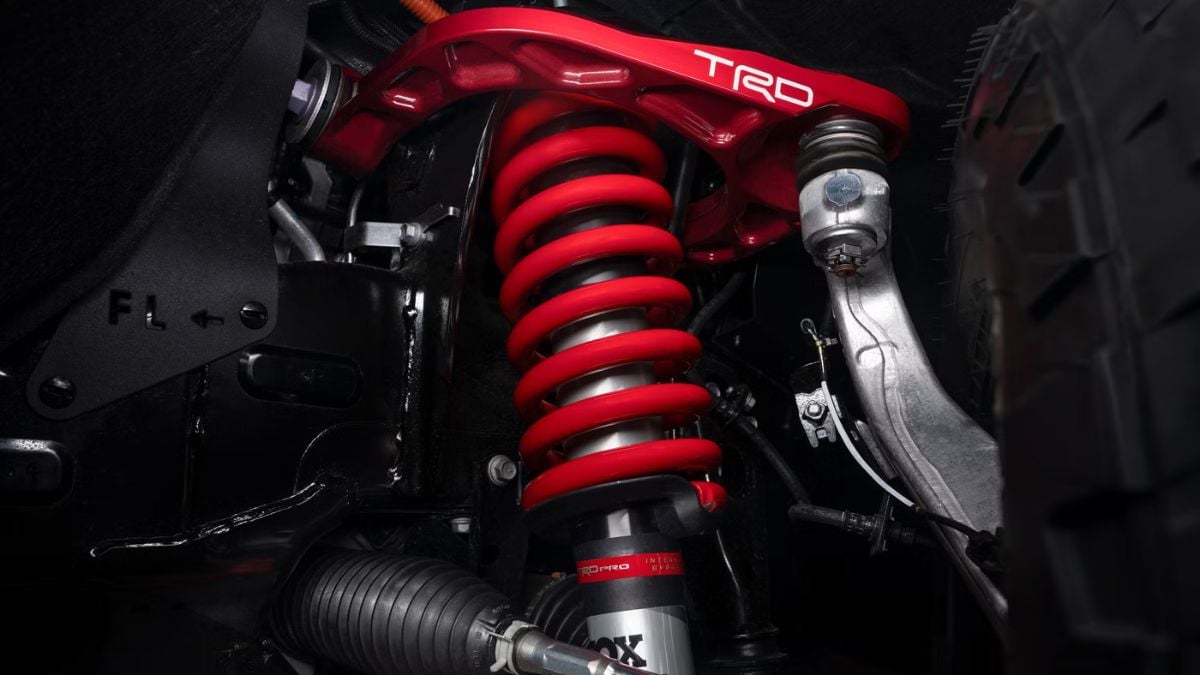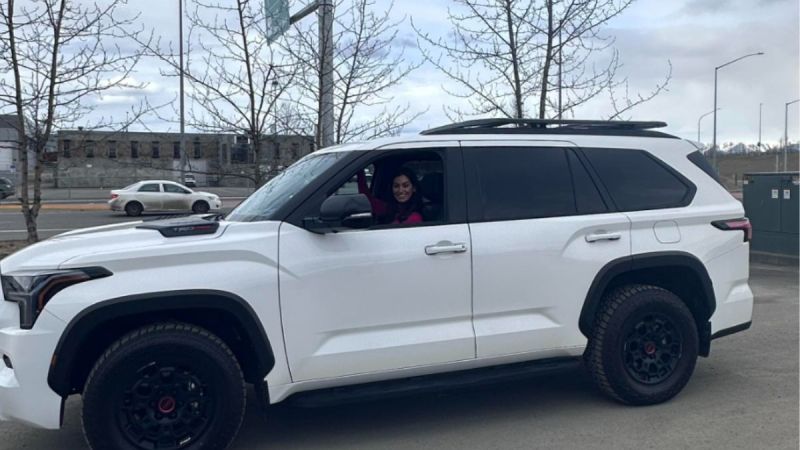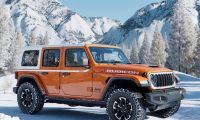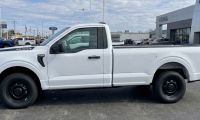You can spend months researching towing capacity charts, watching review videos, and getting convinced that an SUV like the Toyota Sequoia TRD Pro will be the perfect do-it-all vehicle. But sometimes reality feels more different than the numbers suggest. This morning, I was scrolling through the “2022-2026 Toyota Sequoia” group on Facebook and came across a post by Leslie Anne, who learned that firsthand. Leslie bought the Sequoia TRD Pro thinking it would strike the ideal balance between family comfort and towing muscle. But once she hitched up her 31-foot, 6,000-pound camper, the experience quickly turned nerve-wracking. Even with weight distribution bars, the trailer swayed constantly, leaving her questioning whether she made the right choice, or if a proper truck would’ve been the smarter move.
Leslie wrote, “I have the TRD Pro… I was sold on the towing capacity but my 31’ 6,000 lb camper sways awfully even with the weight distribution bars. Feeling pretty bummed I didn’t go with a truck. Anyone else towing with their Sequoia?”
The Numbers Don’t Tell the Whole Story
Tow ratings can be misleading when viewed in isolation. Leslie’s camper weighs well within the Sequoia TRD Pro’s limits, but length, wind drag, and road stability introduce new challenges. Many buyers assume that if their trailer is under the max tow rating, they’re in the clear. But real-world dynamics like trailer sway don’t always cooperate.
The issue isn’t just about weight, but about physics. A longer camper like Leslie’s creates a larger surface area for crosswinds, and an SUV’s shorter wheelbase compared to a full-size truck can lead to instability. Even the best weight-distribution setup can’t fully eliminate that sway if the vehicle geometry just isn’t ideal for long-trailer towing.

What Other Owners Are Saying
Leslie’s concerns sparked a helpful and honest conversation in the comments. Some owners backed up her experience with their own struggles, while others pointed out techniques or tips that made towing more manageable.
Ryan Elsey offered a seasoned perspective: “I towed a 31’ last summer with my Raptor. At a certain length, the wind just catches the trailer like crazy no matter what you’re towing with. Short of a 3/4 or 1 ton, you’re gonna notice it.”
Ryan’s comment really sums up the heart of the issue. No matter how capable the SUV might seem, certain trailers test the limits of physics. Rigs beyond a certain length simply benefit from the added mass and stability of a heavy-duty truck. Even a performance off-roader like the Ford Raptor struggles with this issue, so it’s not a knock on the Sequoia specifically, as it’s a broader conversation about vehicle type.
Ashley Phillips chimed in with practical advice and a more optimistic tone: “We tow our 30ft Coleman and we have had to make some adjustments, but I think we have got it almost figured out. Definitely have to make sure to air up the tires well on both the trailer and vehicle. Empty out all tanks and fully place the weight at the front of the camper. Regardless of good or windy conditions, it’s best to keep speeds at 65 tops.”
Her input reminds us that setup can make or break the towing experience. From tire pressure to load distribution, the little things add up. It doesn’t erase the core concern about the Sequoia’s short wheelbase, but it shows that knowledge and adjustments can sometimes turn a rough experience into a manageable one.
On the other end of the discussion, Charles Dodd pushed back on the idea that SUVs are inherently worse for towing: “Towing with the Sequoia is no different than towing with a truck when it comes to sway. I tow a lot and there is no difference. It's all about tongue weight and distribution. If you distribute the weight and get the tongue height proper, you'll be ok.”
Charles’s view reflects the group that believes the driver’s setup decisions matter more than the platform. While that might be true for shorter or lighter trailers, Leslie’s story still highlights the difficulty of towing large campers even when all the boxes are checked.
A Deeper Look at the Sequoia’s Towing Identity
The third-generation Toyota Sequoia, redesigned for 2023, is built on the same TNGA-F platform as the Tundra, which naturally brings with it some serious improvements. But while it may share the bones of a truck, its ride tuning, interior layout, and rear overhang are still tailored for SUV versatility over brute towing strength.
Even in its most rugged trim, the TRD Pro, the Sequoia aims to balance off-road capability with daily usability. That means a suspension geared more for articulation than load stability, and a wheelbase that’s shorter than a proper truck. While the 2025 Toyota Sequoia Capstone offers luxurious towing ability, it still might not be ideal for towing something as long and tall as Leslie’s camper.
In contrast, owners who’ve stepped into Toyota’s truck lineup tend to report greater towing confidence. In another story, I wrote about an owner who after owning a Sequoia and later moving to a 2025 Toyota Tundra for towing duties, the change was more than just noticeable, as it was transformative.
So from my perspective, this story perfectly illustrates how real-world use cases challenge marketing numbers. It’s easy to get sold on big towing figures. But when you’re white-knuckling the wheel with a 31-foot camper swaying behind you, all that confidence is now being put to the test.
I think the Sequoia is a brilliant vehicle for the right buyer. It’s capable, refined, and far more efficient than its predecessors. But it also walks a fine line between being a family SUV and a towing machine. When you start towing at the limits, you’re no longer in a comfortable middle ground, because you’re starting to step into a space where trucks still dominate for a reason.
That’s not to say you need a 2500HD to tow a camper, but you do need to understand how wheelbase, hitch height, suspension tuning, and trailer aerodynamics come together. And sometimes, a traditional half-ton truck like the Tundra, especially when tuned specifically for towing, just makes more sense. Even those switching from to a Toyota Tundra TRD Pro helped clarify what good towing should feel like.
Key Takeaways for Towing with a Sequoia
- Tow ratings don’t tell the full story. A 6,000 lb trailer may seem safe on paper, but length and wind resistance drastically affect stability.
- Setup matters, but it has its limits. Tire pressure, weight distribution, and tongue height are important, but can’t always overcome a short wheelbase or soft suspension.
- Community insights are valuable. Hearing from people shows how experiences can vary widely, and it proves why doing your homework is key.
- Think beyond the specs. Before committing to an SUV for towing, try to test your exact trailer combo or speak with someone who tows something similar. Even articles like this one highlighting upcoming Tundra changes can shed light on evolving platforms.
What About You?
Have you ever towed a camper with an SUV like the Sequoia? Did it feel secure or were you left wanting the stability of a pickup truck?
And if you had to purchase your vehicle again, would you stick with your SUV or go straight to a truck instead?
Share your experience in the comments below, as we’d love to hear what worked (or didn’t) for you.
Aram Krajekian is a young automotive journalist bringing a fresh perspective to his coverage of the evolving automotive landscape. Follow Aram on X and LinkedIn for daily news coverage about cars.
Images Sources: Toyota Gallery and the “2022-2026 Toyota Sequoia” public Facebook group.












Comments
I had a Nissan Frontier that…
Permalink
I had a Nissan Frontier that was rated to tow 6,500 lb. I towed a 3,500 lb 22’ trailer home, and the wind was throwing that trailer all over. I knew I needed a heavier truck. Got a RAM 2500 Cummins. Overkill for sure, but I eventually moved up to a 30’ toy hauler, and this truck tows it great!
That sounds like a smart…
Permalink
In reply to I had a Nissan Frontier that… by Chris (not verified)
That sounds like a smart upgrade Chris.
You definitely felt the limits early and planned ahead. The 2500 Cummins might’ve been overkill at first, but it clearly paid off in the long run.
A very misleading article…
Permalink
A very misleading article. It's not the vehicle's fault, it's the length of the trailer and how it's built
Nonsense. The rear…
Permalink
In reply to A very misleading article… by Pete (not verified)
Nonsense. The rear suspension on that SUV is soft so that mom can take the kids to the soccer field. It is not made for serious towing. The problem isn't that it's not a pickup truck, the problem is that SUVs have been watered down for decades, destroying their "truck like" features to get them to compete with little crossovers and making them into glorified station wagons. A leaf sprung Suburban or Tahoe from the 90s would pull this trailer no problem.
I keep saying Toyota is…
Permalink
In reply to Nonsense. The rear… by No (not verified)
I keep saying Toyota is making a mistake by not building s 6.7 diesel engine. And now they want these small turbo engines that can't do what a regular engine can.
Nowhere in the article…
Permalink
In reply to I keep saying Toyota is… by Wolverine68 (not verified)
Nowhere in the article mention lack of power/torque. The problem was almost guaranteed the wrong height hitch and or wrong distribution of weight. Too much or too little weight on the tongue and trailer sways. Adding a "6.7" diesel to this wouldnt change anything. And why does toyota need specifically a 6.7l diesel? That's a strange assumption to make.
I totally get where you're…
Permalink
In reply to I keep saying Toyota is… by Wolverine68 (not verified)
I totally get where you're coming from. Toyota’s move toward smaller turbo engines has seemingly left a gap for those who need more serious towing power.
I have a Tundra and have no…
Permalink
In reply to A very misleading article… by Pete (not verified)
I have a Tundra and have no issues with Towing my 32 foot camper. Use your weight distribution hitch and sway bars
Ding Ding Ding. I can't…
Permalink
In reply to I have a Tundra and have no… by Scott Avery (not verified)
Ding Ding Ding. I can't believe it took so long for someone to finally say that this persons problem is lack of towing experience. Probably way too little tongue weight and no mention of sway control. People think that the weight distribution hitch will eliminate all sway....... It will not
It's the lame turbo stuff…
Permalink
In reply to A very misleading article… by Pete (not verified)
It's the lame turbo stuff.
Would have happened on a Tundra as well.
Did I miss the part in the…
Permalink
In reply to It's the lame turbo stuff… by Wolverine68 (not verified)
Did I miss the part in the article where power was the issue? Or was it sway which has nothing to do with power and everything to do with weight and height of tongue?
Completely agree. To much…
Permalink
In reply to A very misleading article… by Pete (not verified)
Completely agree. To much weight in the back will make a trailer sway. We had a 486 pound Heilite pop up trailer that swayed uncontrollably because it had no weight up front. Ended up having to weld 2 weights to the tongue.
We also pull boats, trailers, and airstreams. Our Honda Pilot out tows out 1994 F150 with the 351w any day.
That’s a great example Seth…
Permalink
In reply to Completely agree. To much… by Seth McKay (not verified)
That’s a great example Seth.
Tongue weight balance makes a huge difference, no matter how light the trailer. And it’s wild how far newer SUVs like the Pilot have come. Thanks for sharing your experience.
I 100% believe that Leslie…
Permalink
I 100% believe that Leslie has no idea what she is doing. Weight distribution is key. The Sequoia is literally the suv version of the tundra. When she mentioned how it swayed at 65, I immediately knew that the trailer was not loaded properly. People need to learn how to do things instead of just guessing. We live in the age of the internet, and it is incredibly easy to look up hot to do almost anything, including how to properly load a trailer.
Exactly! People are so…
Permalink
In reply to I 100% believe that Leslie… by Terri Tacoma (not verified)
Exactly! People are so caught up in using terms like truck they forget the science of things. Largely, trucks and SUVs are the same in a grade and built on the same platforms. The Sequoia and Tundra only are different cause SUVs have internal storage making them cost more.
The smart choice is to not…
Permalink
The smart choice is to not have a trailer that big. I wish the DOT banned regular people from towing huge trailers they have no business driving.
OK, then move to China or…
Permalink
In reply to The smart choice is to not… by Veganpotter (not verified)
OK, then move to China or some fascist place instead of a free country.
How about instead of fascist laws we go back to educating people!?!
It sounds like your camper…
Permalink
It sounds like your camper is the problem, not the vehicle. I have towed almost 8,000 lbs with my wife's '24 Sequoia (loaded horse trailer) on several different occasions and it tows it fine at 70 mph all day long. These were/are several hundred mile trips and no issues.
That’s really helpful to…
Permalink
In reply to It sounds like your camper… by Arnold (not verified)
That’s really helpful to hear Arnold.
Sounds like your setup is well dialed in. It’s true that trailer design, balance, and even tires can totally change the towing experience, regardless of the vehicle. Appreciate you adding that perspective.
"...an SUV’s shorter…
Permalink
"...an SUV’s shorter wheelbase compared to a full-size truck can lead to instability."
Ram 1500 Regular Cab 6.5' bed = 120.5"
Toyota Sequoia wheelbase = 122.0"
Ford F150 Regular Cab 6.5' bed = 122.8"
Chevy Silverado 1500 Regular Cab 6.5' bed = 126.5"
Those are all "full-sized trucks."
People see the word suv and…
Permalink
In reply to "...an SUV’s shorter… by PJ (not verified)
People see the word suv and go dense entirely and think it is this or that, but the truth of the matter is that this stuff is built on different platforms depending on suv size and the like. Like let's use the Honda CRV... that is largely built on the accord platform and isn't meant to tow much, but something kine the Sequoia is built off a truck platform entirely and just changed the interior and back to not have a truck bed..
Vehicle tow ratings are…
Permalink
Vehicle tow ratings are becoming increasingly high. Real world towing might be 50% of rated. The mileage must also be horrible when towing maxed out with a gas motor too. A friend used a Tundra to tow a 35ft travel trailer and averaged 4 mpg and could only hit 45 mph up mountain grades. My truck is rated for 20k towing and my 10k 5th wheel is perfect. Anything else would be too much for long distance vacations
My 2017 tundra get 9-10mpg…
Permalink
In reply to Vehicle tow ratings are… by Scott (not verified)
My 2017 tundra get 9-10mpg towing my 33ft. travel trailer.
Get a proper hitch, they may be between $1,200-3k but it will make a world of difference towing and you won't have to get a 3/4 ton to tow 6k.
That’s a great point Scott…
Permalink
In reply to Vehicle tow ratings are… by Scott (not verified)
That’s a great point Scott.
Tow ratings on paper don’t always reflect the real-world experience, especially with gas engines under full load. Sounds like your setup is right in the sweet spot for power, control, and long-haul comfort.
Color me shocked, the off…
Permalink
Color me shocked, the off-road vehicle struggles at towing. Off-road and comfort focused vehicles have softer suspension to absorb bumps, but yeah that isn't good for towing and hauling.
Pulling a large camper isn’t…
Permalink
Pulling a large camper isn’t just about engine power—it’s about overall towing safety, stability, and control. Here’s why you should use at least a ¾ ton truck (like an F-250, Ram 2500, or Silverado 2500) or bigger:
Weight distribution hitches (WDHs) are often marketed as a fix for squatting tow vehicles—but they come with major downsides, especially when pushing the limits of your vehicle. A WDH transfers tongue weight to the front axle and trailer axles, which may level your ride height but doesn’t solve the real problem—overloaded suspension or inadequate tow vehicle. When going over uneven terrain or dips, WDHs can bind and restrict proper movement, which stresses the hitch, frame, and trailer tongue. There are real-world cases where WDHs have cracked or buckled frames—especially on SUVs, crossovers, or half-ton trucks. There are real-world cases where WDHs have cracked or buckled frames—especially on SUVs, crossovers, or half-ton trucks. Always tow under your vehicle’s rating, not up to it. Give yourself margin for safety, weather, and load creep.
Well said Ben. Towing safely…
Permalink
In reply to Pulling a large camper isn’t… by Ben Witek (not verified)
Well said Ben.
Towing safely isn’t just about hitting the numbers on paper, it’s about having the right platform underneath you. Margin matters, and a heavier-duty truck often makes the difference between white-knuckling and cruising confidently.
There are good instruction…
Permalink
There are good instruction resources about towing. Trailer weight and vehicle towing capacity are just the beginning. Rated towing capacity is a maximum base on flat and level terrain. Personally, I believe a loaded RV trailer should not exceed 65% of the tow vehicle's rated capacity. Other critical factors include tow vehicle wheelbase, trailer length, hitch weight, and even tire models and inflation. The dealers aren't going to tell the customers about anything, except maybe weight capacity of the tow vehicle. Finally, trailer weight on the sticker is nominal. Actual weight after it is loaded for travel has to be verified on a scale, as does hitch weight. Weight distributing hitches have to be properly adjusted. The hitches come with instructions for that too. It is up to the owner to figure all this stuff out. Some pay a steep price for not being aware of the pitfalls before hitching up. It is a "buyer beware" world in the RV trailer business.
Absolutely Steve. Towing…
Permalink
In reply to There are good instruction… by Steve Simmer (not verified)
Absolutely Steve.
Towing safely goes way beyond just matching trailer weight to tow rating. Your 65% rule is a smart guideline, and you’re right: wheelbase, hitch setup, and even tires can make or break the experience. It really is up to owners to dig deeper than the brochure.
Not all weight distribution…
Permalink
Not all weight distribution hitches are equal when it comes to sway control. Sway control is all about friction at the pivot point between truck and trailer. Likely this setup does not have enough friction.
Pagination